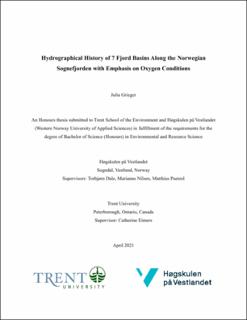| dc.description.abstract | Oxygen concentration, temperature and salinity within the Barsnesfjorden, Sogndalsfjorden, Nærøyfjorden, Ikjefjorden, Østerbøvatn, Fuglsetfjorden and Finnabotn in Western Norway were profiled over time and along the water column of each basin. Bathymetric maps for each fjord were presented and the locations of wastewater plants and hydropower plants along the Sognefjorden were identified. The basin water of the Barsnesfjorden, Sogndalsfjorden, Nærøyfjorden, and Ikjefjorden was found to be getting more anoxic over time. Temperature was found to be increasing over time, and results regarding salinity were varied. While the data available for the Østerbøvatn, Fuglsetfjorden and Finnabotn was not comprehensive enough to observe long-term trends, the baseline conditions of these fjords were found to be anoxic. Oxygen depletion was tied to increasing temperatures resulting from climate change and decreasing salinity associated with positive North Atlantic Oscillation trends and hydropower activities that resulted in reduced inflow frequencies. Increased temperatures had more negative effects on oxygen levels than salinity including warmer water containing less oxygen than cooler water, warmer temperatures decreasing water density which reduces inflow frequencies, and increased temperatures resulting in increased oxygen consumption rates. It was suggested based on these findings that the EU Water Framework Directive classifications for these fjords should be revisited due to how the changing climate and anthropogenic impacts have affected fjord processes. Additionally, classification systems for fjords such as LENKA need to take these factors into account as well. The effects seen in these fjords are likely analogous to those occurring in other Western Norwegian fjords, and it was suggested that future studies should continue to monitor changing oxygen levels across coastal waters and fjords. | en_US |

